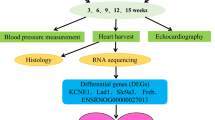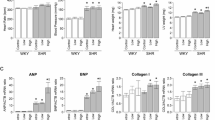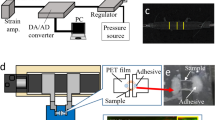Abstract
Cardiac hypertrophy and left ventricular hypertrophy are known to be substantially controlled by genetic factors. As an experimental model, we undertook genome-wide screens for cardiac mass in F2 populations bred from the stroke-prone spontaneously hypertensive rats (SHRSP) and normal spontaneously hypertensive rats (SHR) and Wistar Kyoto rats (WKY) of a Japanese colony. Two F2 cohorts were independently produced: F2(SHRSP × WKY) (110 male and 110 female rats) and F2(SHRSP × WKY) (151 male rats). The ratio of heart weight to body weight (Hw/Bw) was evaluated at 12 months of age in F2(SHRSP × WKY) after salt-loading for 7 months, and at around 15 weeks of age in F2(SHRSP × WKY) who had been fed a normal rat chow diet. Subsequent to an initial screen with 251 markers in F2(SHRSP × WKY) male progeny, 170 and 161 markers were selected and characterized in F2(SHRSP × WKY) female progeny and F2(SHRSP × WKY) male progeny, respectively. Markers from four chromosomal regions showed suggestive or significant linkage to Hw/Bw. The strongest and the most consistent linkage was found in the vicinity of D3Mgh16 on rat chromosome (RNO) 3 (a maximal log of the odds score reached 4.0 to 6.6 across the F2 populations studied). In the other three regions on RNO6, RNO10 and RNO13, the degree of linkage was more prominent in either males or females. These data provide solid evidence for a “principal” RNO3 quantitative trait loci regulating Hw/Bw in SHRSP and SHR, and also suggest the possible presence of sexual dimorphism in regard to genetic susceptibility for cardiac hypertrophy.
Similar content being viewed by others
Article PDF
References
Arnett DK, de las Fuentes L, Broeckel U : Genes for left ventricular hypertrophy. Curr Hypertens Rep 2004; 6: 36–41.
Verhaaren HA, Schieken RM, Mosteller M, Hewitt JK, Eaves LJ, Nance WE : Bivariate genetic analysis of left ventricular mass and weight in pubertal twins (the Medical College of Virginia twin study). Am J Cardiol 1991; 68: 661–668.
Post WS, Larson MG, Myers RH, Galderisi M, Levy D : Heritability of left ventricular mass: the Framingham Heart Study. Hypertension 1997; 30: 1025–1028.
Gardin JM, Henry WL, Savage DD, Ware JH, Burn C, Borer JS : Echocardiographic measurements in normal subjects: evaluation of an adult population without clinically apparent heart disease. J Clin Ultrasound 1979; 7: 439–447.
Chaturvedi N, Athanassopoulos G, McKeigue PM, Marmot MG, Nihoyannopoulos P : Echocardiographic measures of left ventricular structure and their relation with rest and ambulatory blood pressure in blacks and whites in the United Kingdom. J Am Coll Cardiol 1994; 24: 1499–1505.
Tanase H, Yamori Y, Hansen CT, Lovenberg W : Heart size in inbred strains of rats. Part 1. Genetic determination of the development of cardiovascular enlargement in rats. Hypertension 1982; 4: 864–872.
Rapp JP : Genetic analysis of inherited hypertension in the rat. Physiol Rev 2000; 80: 135–172.
Kato N, Hyne G, Bihoreau MT, Gauguier D, Lathrop GM, Rapp JP : Complete genome searches for quantitative trait loci controlling blood pressure and related traits in four segregating populations derived from Dahl hypertensive rats. Mamm Genome 1999; 10: 259–265.
Innes BA, McLaughlin MG, Kapuscinski MK, Jacob HJ, Harrap SB : Independent genetic susceptibility to cardiac hypertrophy in inherited hypertension. Hypertension 1998; 31: 741–746.
Pravenec M, Gauguier D, Schott JJ, et al: Mapping of quantitative trait loci for blood pressure and cardiac mass in the rat by genome scanning of recombinant inbred strains. J Clin Invest 1995; 96: 1973–1978.
Kato N, Mashimo T, Nabika T, Cui ZH, Ikeda K, Yamori Y : Genome-wide searches for blood pressure quantitative trait loci in the stroke-prone spontaneously hypertensive rat of a Japanese colony. J Hypertens 2003; 21: 295–303.
Clark JS, Jeffs B, Davidson AO, et al: Quantitative trait loci in genetically hypertensive rats. Possible sex specificity. Hypertension 1996; 28: 898–906.
Yagil C, Sapojnikov M, Kreutz R, et al: Salt susceptibility maps to chromosomes 1 and 17 with sex specificity in the Sabra rat model of hypertension. Hypertension 1998; 31: 119–124.
Kato N, Tamada T, Nabika T, et al: Identification of quantitative trait loci for serum cholesterol levels in stroke-prone spontaneously hypertensive rats. Arterioscler Thromb Vasc Biol 2000; 20: 223–229.
Bihoreau MT, Gauguier D, Kato N, et al: A linkage map of the rat genome derived from three F2 crosses. Genome Res 1997; 7: 434–440.
Jacob HJ, Brown DM, Bunker RK, et al: A genetic linkage map of the laboratory rat, Rattus norvegicus. Nat Genet 1995; 9: 63–69.
Kato N, Nabika T, Liang YQ, et al: Isolation of a chromosome 1 region affecting blood pressure and vascular disease traits in the stroke-prone rat model. Hypertension 2003; 42: 1191–1197.
Lander ES, Green P, Abrahamson J, et al: MAPMAKER: an interactive computer package for constructing primary genetic linkage maps of experimental and natural populations. Genomics 1987; 1: 174–181.
Lander E, Kruglyak L : Genetic dissection of complex traits: guidelines for interpreting and reporting linkage results. Nat Genet 1995; 11: 241–247.
Siegel AK, Planert M, Rademacher S, et al: Genetic loci contribute to the progression of vascular and cardiac hypertrophy in salt-sensitive spontaneous hypertension. Arterioscler Thromb Vasc Biol 2003; 23: 1211–1217.
Sebkhi A, Zhao L, Lu L, Haley CS, Nunez DJ, Wilkins MR : Genetic determination of cardiac mass in normotensive rats: results from an F344×WKY cross. Hypertension 1999; 33: 949–953.
Deschepper CF, Masciotra S, Zahabi A, Boutin-Ganache I, Picard S, Reudelhuber TL : Functional alterations of the Nppa promoter are linked to cardiac ventricular hypertrophy in WKY/WKHA rat crosses. Circ Res 2001; 88: 223–228.
Tsujita Y, Iwai N, Tamaki S, Nakamura Y, Nishimura M, Kinoshita M : Genetic mapping of quantitative trait loci influencing left ventricular mass in rats. Am J Physiol Heart Circ Physiol 2000; 279: H2062–H2067.
Kren V, Pravenec M, Lu S, et al: Genetic isolation of a region of chromosome 8 that exerts major effects on blood pressure and cardiac mass in the spontaneously hypertensive rat. J Clin Invest 1997; 99: 577–581.
Hamet P, Kaiser MA, Sun Y, et al: HSP27 locus cosegregates with left ventricular mass independently of blood pressure. Hypertension 1996; 28: 1112–1117.
Zhang L, Summers KM, West MJ : Analysis of linkage of the ACE locus with measures of cardiac hypertrophy in the spontaneously hypertensive rat. Clin Exp Pharmacol Physiol 1996; 23: 597–599.
Zhang L, Summers KM, West MJ : Angiotensin I converting enzyme gene cosegregates with blood pressure and heart weight in F2 progeny derived from spontaneously hypertensive and normotensive Wistar-Kyoto rats. Clin Exp Hypertens 1996; 18: 753–771.
Harris EL, Phelan EL, Thompson CM, Millar JA, Grigor MR : Heart mass and blood pressure have separate genetic determinants in the New Zealand genetically hypertensive (GH) rat. J Hypertens 1995; 13: 397–404.
Katsuya T, Takami S, Higaki J, et al: Gap junction protein locus on chromosome 18 cosegregates with body weight in the spontaneously hypertensive rat. Hypertens Res 1995; 18: 63–67.
Kato N, Kanda T, Sagara M, et al: Proposition of a feasible protocol to evaluate salt sensitivity in a population-based setting. Hypertens Res 2002; 25: 801–809.
O'Donnell CJ, Lindpaintner K, Larson MG, et al: Evidence for association and genetic linkage of the angiotensin-converting enzyme locus with hypertension and blood pressure in men but not women in the Framingham Heart Study. Circulation 1998; 97: 1766–1772.
Higaki J, Baba S, Katsuya T, et al: Deletion allele of angiotensin-converting enzyme gene increases risk of essential hypertension in Japanese men: the Suita Study. Circulation 2000; 101: 2060–2065.
Katsuya T, Ishikawa K, Sugimoto K, Rakugi H, Ogihara T : Salt sensitivity of Japanese from the viewpoint of gene polymorphism. Hypertens Res 2003; 26: 521–525.
Mashimo T, Nabika T, Matsumoto C, et al: Aging and salt-loading modulate blood pressure QTLs in rats. Am J Hypertens 1999; 12: 1098–1104.
Morgan T : Renin, angiotensin, sodium and organ damage. Hypertens Res 2003; 26: 349–354.
Author information
Authors and Affiliations
Corresponding author
Rights and permissions
About this article
Cite this article
Inomata, H., Watanabe, T., Iizuka, Y. et al. Identification of Quantitative Trait Loci for Cardiac Hypertrophy in Two Different Strains of the Spontaneously Hypertensive Rat. Hypertens Res 28, 273–281 (2005). https://doi.org/10.1291/hypres.28.273
Received:
Accepted:
Issue date:
DOI: https://doi.org/10.1291/hypres.28.273
Keywords
This article is cited by
-
A trans locus causes a ribosomopathy in hypertrophic hearts that affects mRNA translation in a protein length-dependent fashion
Genome Biology (2021)
-
Novel genes on rat chromosome 10 are linked to body fat mass, preadipocyte number and adipocyte size
International Journal of Obesity (2016)
-
Endonuclease G is a novel determinant of cardiac hypertrophy and mitochondrial function
Nature (2011)
-
Identification of genetic loci involved in diabetes using a rat model of depression
Mammalian Genome (2009)



